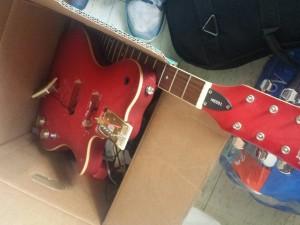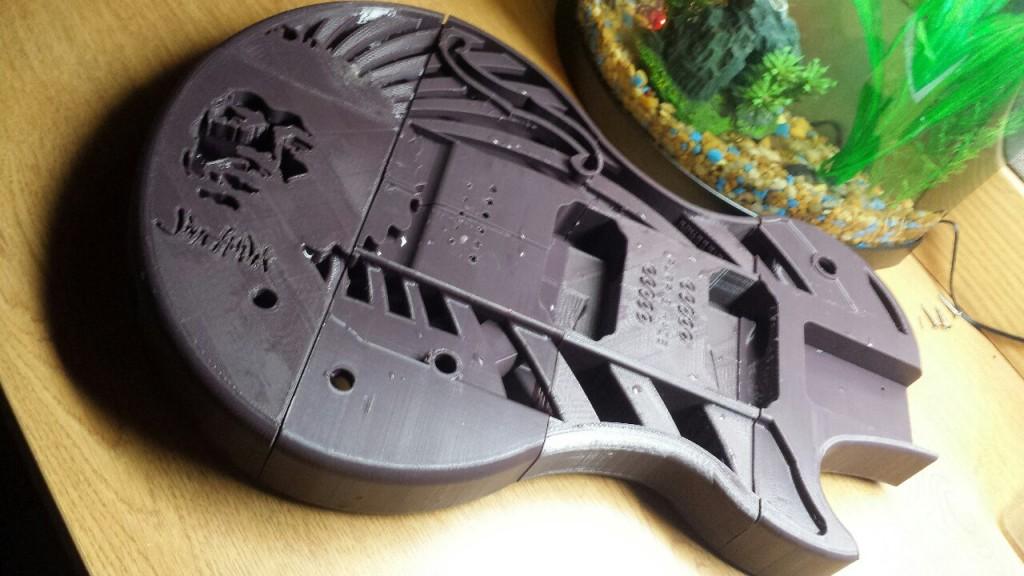Jose Moreno decided that if he wanted to play guitar like Jimi Hendrix he ought to have a guitar like legendary musician whom Rolling Stone magazine hailed as the greatest guitarist of all time. Moreno, an electrical engineering student at Purdue University in West Lafayette, Indiana, is also the Vice President of the Purdue 3D Printing Club, so he was already aware that it would cost him at least $3,000 to buy a 3D printed guitar. They’re somewhat rare at this point, anyway, and Moreno concluded that if he was going to spend that much money, he could “get a nice Gibson for that.”
Moreno decided to make his own 3D printed guitar and to blog on Tumblr about the process. Moreover, he declared that his would be “the cheapest 3D printed guitar ever made (that still looks cool and doesn’t sound like it’s made of plastic).” As an electrical engineer and a musician–he’s in a band called Tower Six–Moreno seems just the person to attempt such a feat. While his blog is short on detailed instructions, he was generous with photos and it’s a fascinating and entertaining read.
 The project began at a pawn shop (possibly better known for endings), where Moreno purchased a used First Act guitar, then measured it to produce a 2D drawing of its dimensions. He disassembled the guitar, which he planned to use for parts, particularly the neck as he doubted that a 3D printed neck would produce decent quality sound.
The project began at a pawn shop (possibly better known for endings), where Moreno purchased a used First Act guitar, then measured it to produce a 2D drawing of its dimensions. He disassembled the guitar, which he planned to use for parts, particularly the neck as he doubted that a 3D printed neck would produce decent quality sound.
Moreno sat down with CAD and after a few hours had come up with a “rough extrusion” of the 2D sketch he’d made.
“The cavities for the hardware are all there,” he explained. “The next step is to 3D print certain parts to see if the hardware physically fits in real life.”
Confident he could handle the technical aspects of designing and 3D printing his guitar, Moreno turned his attention to aesthetics. “…It’s all about making it look cooler than it does now.”
His first 3D printed object wasn’t actually a part for the guitar. Rather, it was a part that would give him a sense of “what kind of clearances work best between interlocking parts.” Moreno knew that he couldn’t print the entire body of the guitar all at once, so printing separate parts that would somehow lock together was the solution he decided was best. He returned to CAD where he began experimenting with the best configurations of interlocking parts, doing some test prints, and returning to CAD to refine.
The second 3D printed part was the neck piece, which is critical because it needs to hold the neck of the guitar securely in place and it can’t warp under the tension from the strings. The first 3D printed neck piece was a bit loose, so Moreno did some tinkering and the next piece was a success.
Moreno continues his blog account, describing with good humor the travails and triumphs of his process, including singing the praises of PLA, particularly with regard to the guitar’s 3D printed PLA bridge, which has the requisite strength to withstand the tension of the strings. In one instance, a failed test print of the neck holder ended up in the aquarium as cave for Moreno’s fish, so nothing was wasted in this 3D printing musical adventure.
Each part was printed at .25mm and 25% infill, he explained, “for the sake of weight and potential sound quality…we don’t want this thing to be too light.” Moreno recommended not using rafts and also emphasized, probably not surprisingly, that some finishing, including sanding, was required.
Eventually, all of the pieces were printed and locked into place and the final “make the guitar look cool” phase began in earnest. Moreno looked to a variety of sources for inspiration for the aesthetics of his Hendrix guitar, including a poster with a silhouette of the man himself. He superimposed the silhouette onto the guitar, incorporating portions of the design into the 3D model. Adding such design details into the actual structure of the guitar simply wouldn’t have been possible without the use of a 3D printer. Moreno wasn’t completely certain how such visually pleasing details might affect the sound quality but he decided to take his chances. In the final CAD design, he made certain adjustments like hollowing out various parts, he conceded, “to showcase the capabilities of a 3D printer and to just make this thing look cool.”
The finished 3D printed guitar is bright purple, which should come as no surprise to any Hendrix fans. Moreno shared a video as his final blog entry; in the video, he demonstrates the sound quality of his impressive 3D printed Jimi Hendrix tribute guitar. To my untrained ears, I have to admit it sounds pretty good. It certainly looks amazing.
Have you seen another 3D printed instrument that came out so well? Let us know what you think in the 3D Printed Jimi Hendrix Guitar forum thread over at 3DPB.com.
Subscribe to Our Email Newsletter
Stay up-to-date on all the latest news from the 3D printing industry and receive information and offers from third party vendors.
You May Also Like
Profiling a Construction 3D Printing Pioneer: US Army Corps of Engineers’ Megan Kreiger
The world of construction 3D printing is still so new that the true experts can probably be counted on two hands. Among them is Megan Kreiger, Portfolio Manager of Additive...
US Army Corps of Engineers Taps Lincoln Electric & Eaton for Largest 3D Printed US Civil Works Part
The Soo Locks sit on the US-Canadian border, enabling maritime travel between Lake Superior and Lake Huron, from which ships can reach the rest of the Great Lakes. Crafts carrying...
Construction 3D Printing CEO Reflects on Being Female in Construction
Natalie Wadley, CEO of ChangeMaker3D, could hear the words of her daughter sitting next to her resounding in her head. “Mum, MUM, you’ve won!” Wadley had just won the prestigious...
1Print to Commercialize 3D Printed Coastal Resilience Solutions
1Print, a company that specializes in deploying additive construction (AC) for infrastructure projects, has entered an agreement with the University of Miami (UM) to accelerate commercialization of the SEAHIVE shoreline...






























